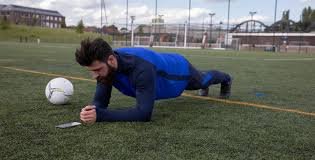Unmasking the Injury Landscape in Amateur Football: Key Insights
Physiotherapists are no stranger to football injuries, with studies reporting that 1 in 4 females, and 1 in 5 males will report a new injury on a weekly basis.
In a recent prospective study spanning from March to October 2020, researchers delved into the world of amateur football to understand injury prevalence, patterns, and the factors that increase risk.
The main goal?
To learn how we can help reduce injury risk!
Over 450 players, both adolescent and adult, willingly participated in this extensive exploration. Here's a concise breakdown of what they discovered:
Injury Incidence:
The study revealed that almost one in five male amateur footballers and one in four female counterparts reported either new or ongoing injuries on a weekly basis.
Gender-Specific Trends:
The types of injuries varied between males and females, most commonly thought to be because of key anatomical differences between the male and female human body (pelvis width, distribution of muscle mass/weight etc).
For men, hip and groin injuries were the most common.
Females experienced a higher prevalence of knee injuries.
Age and Injury History:
Age emerged as a significant risk factor. Older players, particularly those aged 25 and above, were more susceptible to new injuries during the season. Additionally, those with existing injuries at the beginning of the season had a higher likelihood of sustaining new injuries.
Players over the age of 25 and those who reported injuries at the start of the season may benefit from an individualised injury risk mitigation program including training load modifications and off-season plans.
Summary from the research:
These findings underscore the importance of tailored rehabilitation programs for players recovering from pre-season injuries. It's a crucial step in reducing the overall injury burden in amateur football. By recognizing and addressing these risk factors, we can pave the way for safer and more enjoyable play on the field.
Football athlete working his anterior core with a plank. This has been shown to help reduce incidence of hip and groin related injuries.
What does an injury screen look like at Physiologic?:
We will always start off with a thorough subjective questionnaire, where we get to know our athletes’ training history, injury history and what their goals are for the upcoming season.
This will give our Sports Physiotherapists an idea of what to assess when it comes to your specific injury. Typically we would assess a joints range of motion, structural integrity, and strength.
We will always also look at the joints that commonly affect your injury site! For example, if you had a knee injury, we’d also assess the ankle and the hip.
Screening for hip mobility and stability.
Aside from specific testing, we also get you out onto our gym floor to look at how you move, so we can pick up any compensations you may be making, while will then guide our decision making process when it comes to designing your rehabilitation program.
By the end of it - we would be able to tell you what your specific impairments are, and how to work on them through prescriptive exercises and load management strategies.
Need some help?
If you’re preparing for your upcoming football (or other sporting) season and want to have an individual rehabilitation plan created for you, reach out to us for a complete assessment and program creation.
This way, you’ll never feel like your time was wasted in the gym, and you’ll get back to changing the game come game day.
References:
Sonesson S et al (2023), Higher age and present injury at the start of the season are risk factors for in-season injury in amateur male and female football players—a prospective cohort study.
About the Author
Ryan Tan is our Clinical Director and Physiotherapist here at Physiologic Hong Kong. He’s had over 10 years of experience as a sports and musculoskeletal Physiotherapist, having looked after elite athletes such as the NZ Rugby 7’s team and more recently, some of Hong Kong’s top Trail Runners. His post graduate training in Advanced Lower Limb Rehabilitation alongside his Strength and Conditioning qualifications blends clinical expertise with exercise prescription to provide the best recovery journey for his clients, every step of the way.


